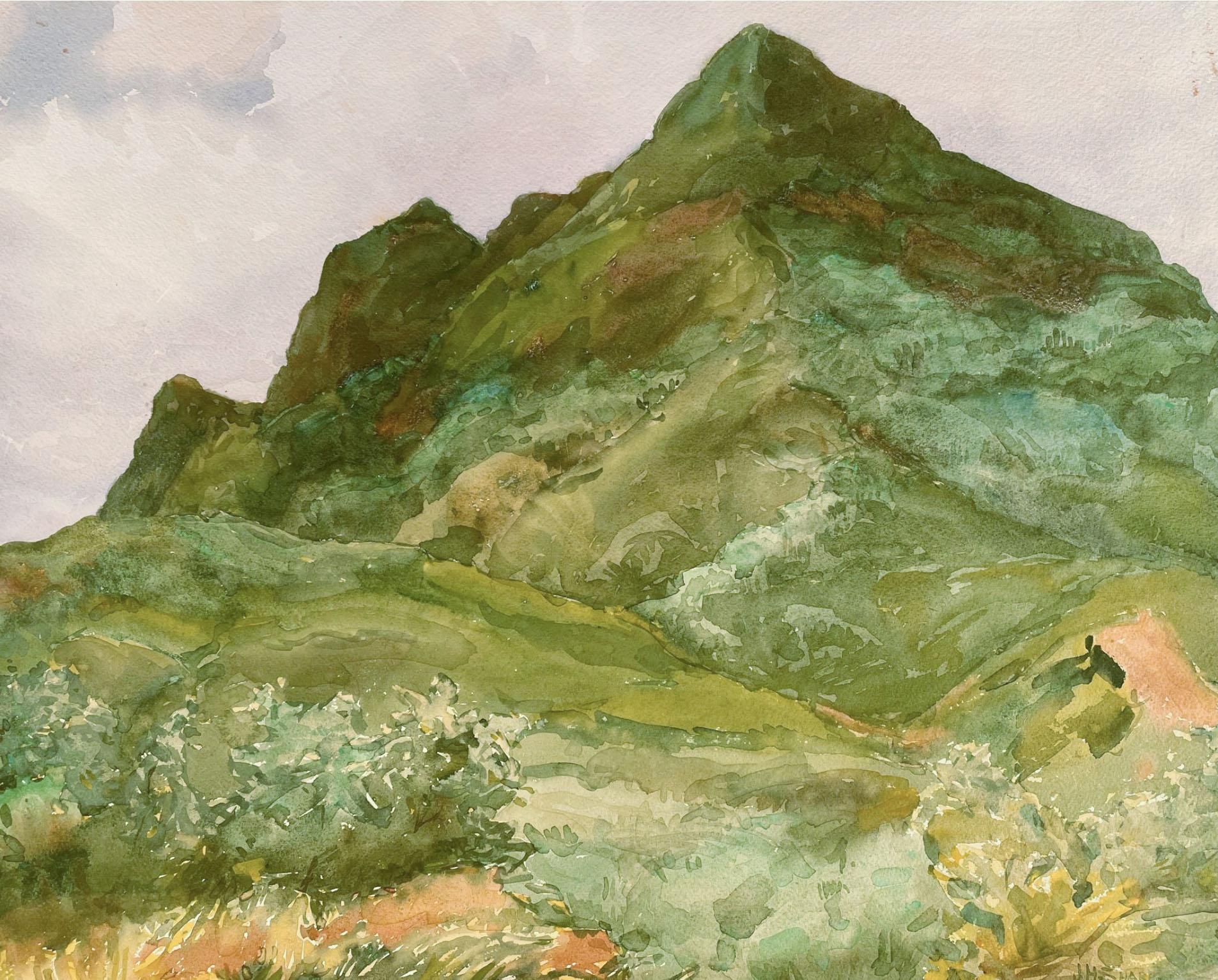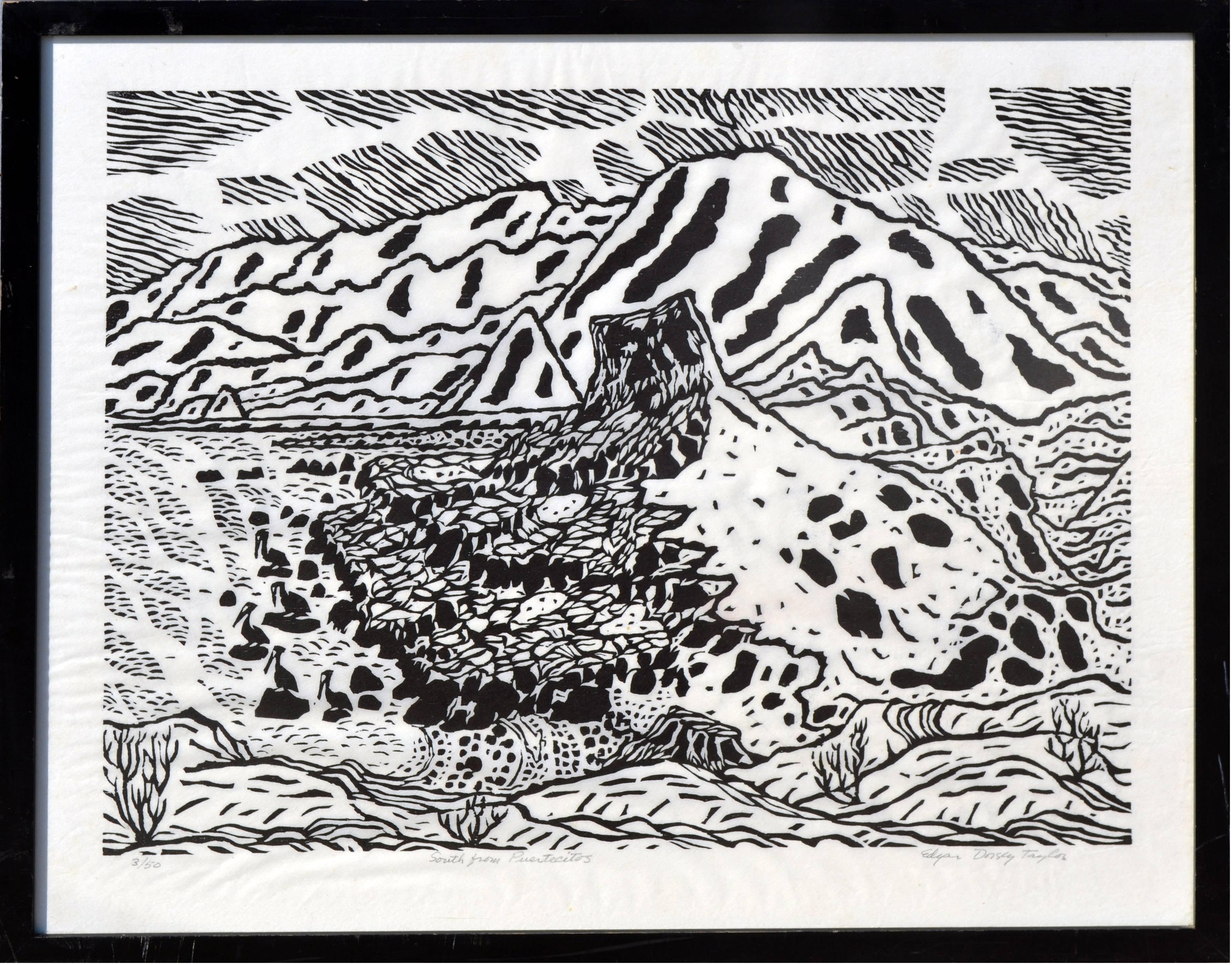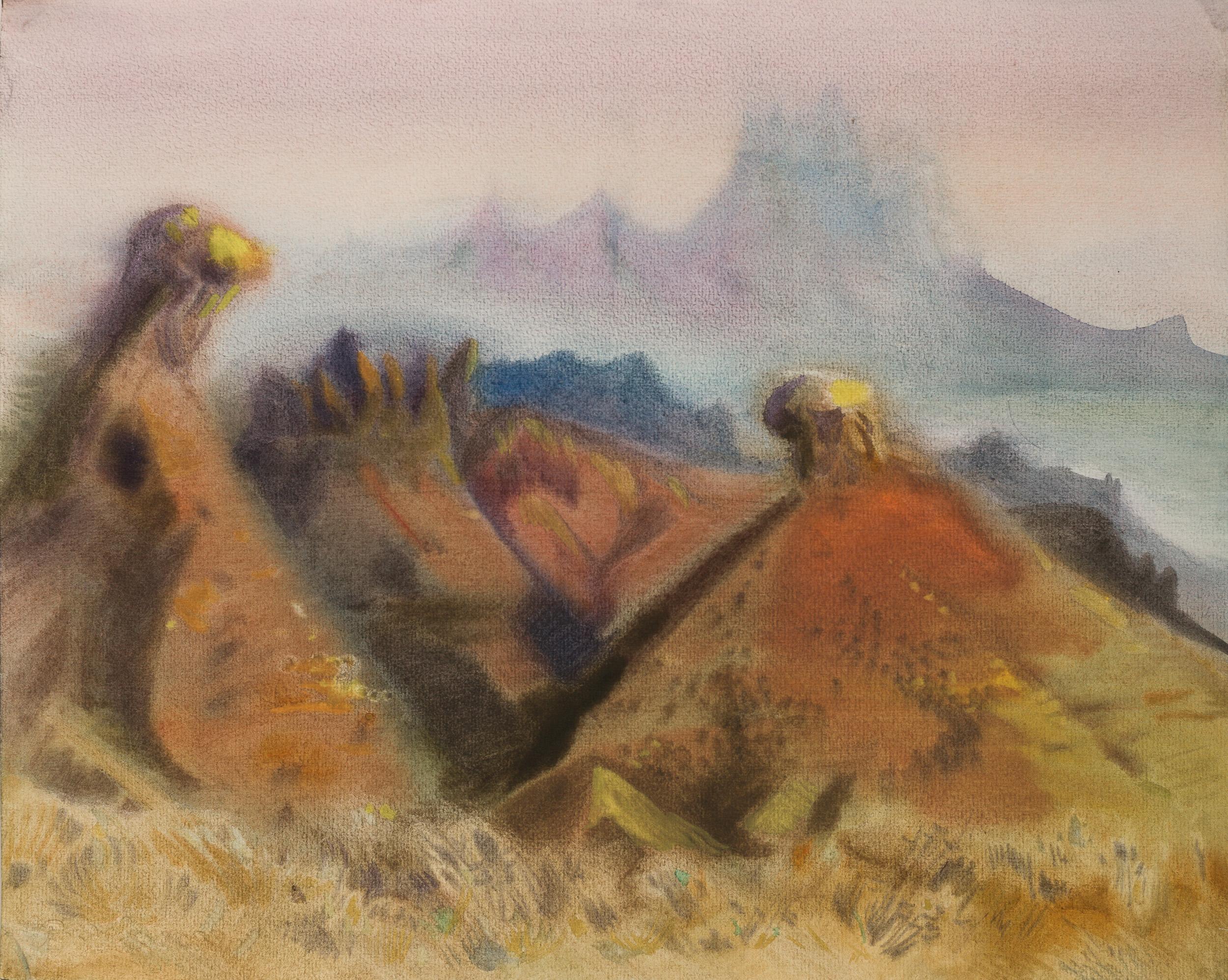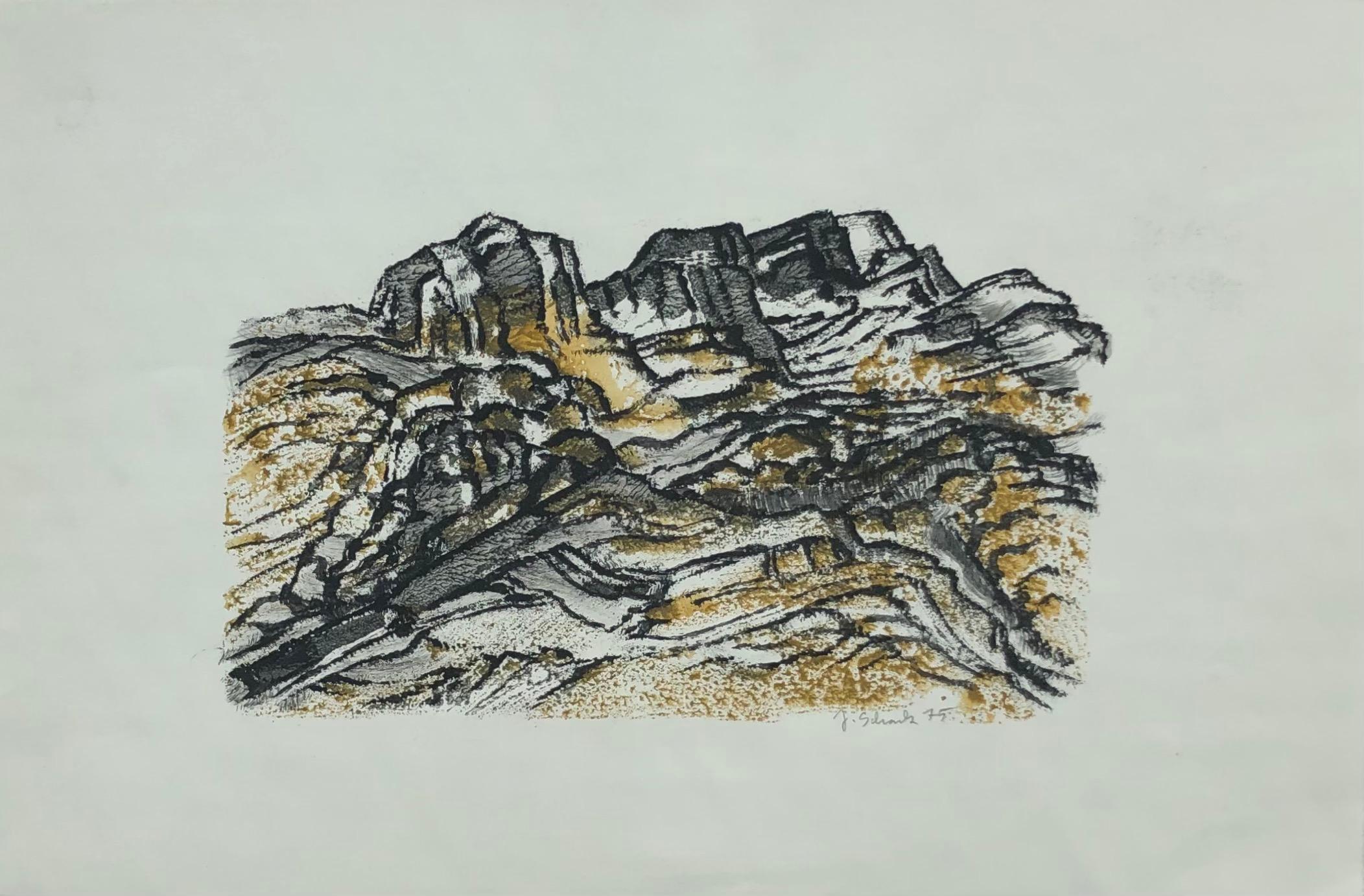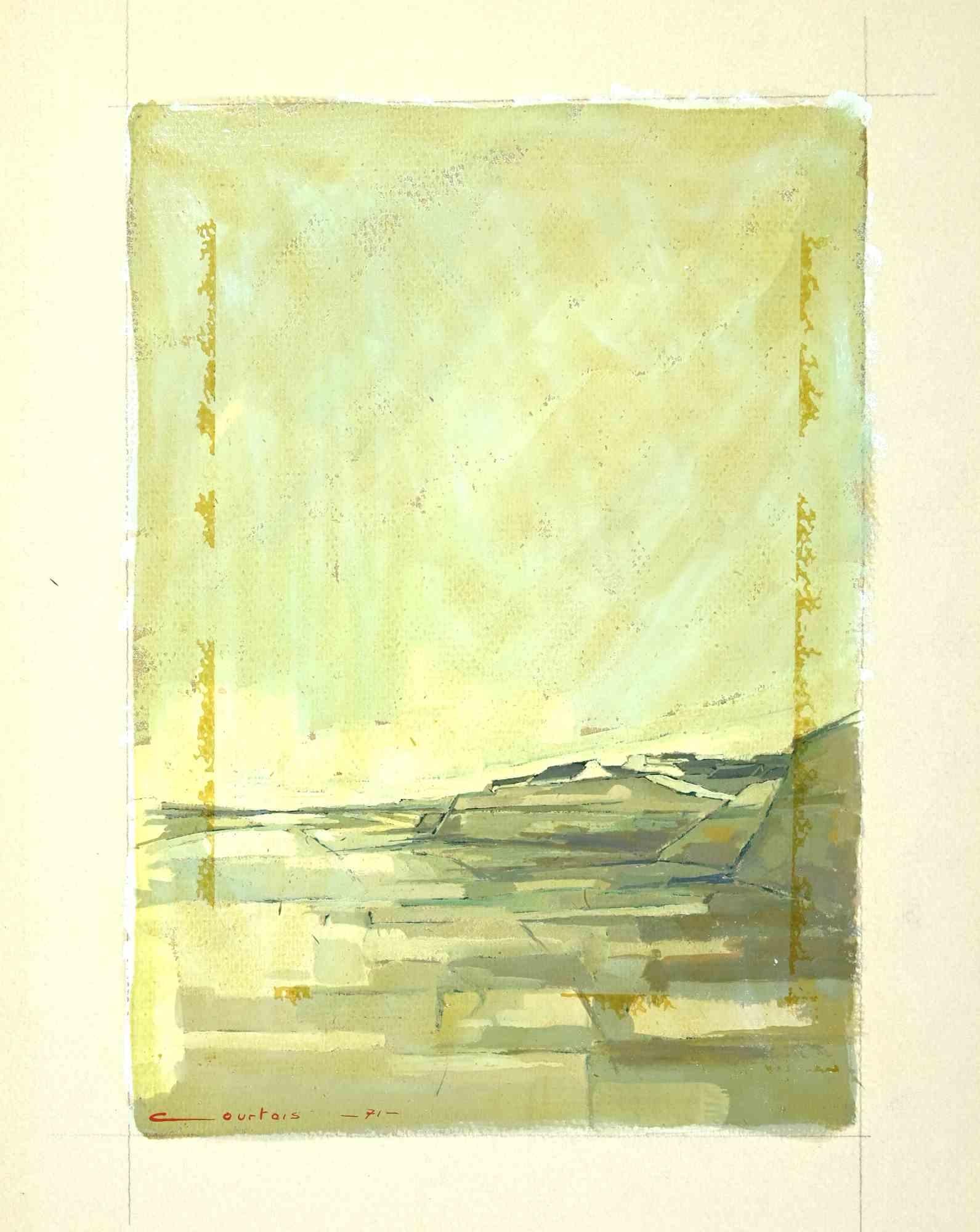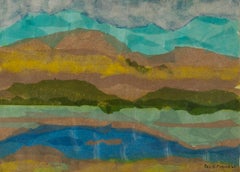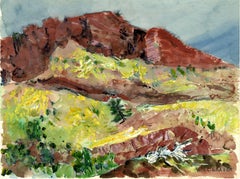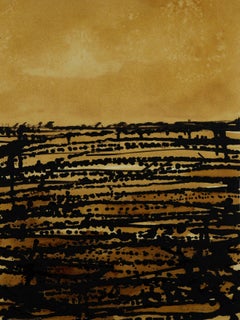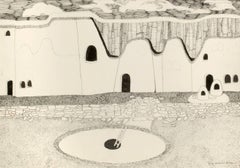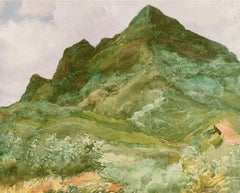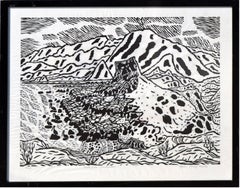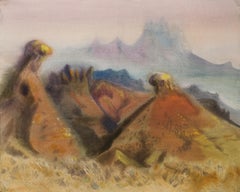Items Similar to Mountainous Landscape, Mexico
Want more images or videos?
Request additional images or videos from the seller
1 of 7
Guillermo CenicerosMountainous Landscape, Mexicoc. 1960
c. 1960
$550
£419.92
€485.22
CA$772.10
A$860.58
CHF 451.52
MX$10,509.10
NOK 5,717.19
SEK 5,403.62
DKK 3,621.38
About the Item
Mountainous Landscape, Mexico
Monotype in colors on heavy paper, c. 1960's
Signed in ink lower left "G Ceniceros"
Condition: Excellent
Image size: 6 x 14 1/2" (15.24 x 36.83cm)
Sheet size: 12 7/8 x 19 11/16 inches
Guillermo Ceniceros (born May 7, 1939) is a Mexican painter and muralist, best known for his mural work in Mexico City, as well as his figurative easel work. He began his mural painting career as an assistant to mural painters such as Federico Cantú, Luis Covarrubias and then David Alfaro Siqueiros who was a mentor and a key influence. Ceniceros is the most notable of Siqueiros' assistants. While he has experimented with abstract expression, his easel work mostly classifies as figurativism and is influenced by the geometrical construct of Mexican muralism. He has had over 300 individual and collective exhibitions in Mexico and the International stage. His work has been recognized by the Mexican Ministry of Culture and several of its institutions. He has painted over 20 large scale Mural Paintings with some of the most notable being the large scale work for the Legislative Palace of San Lazaro (Mexico's Legislative Building) as well as his murals in the Metro Subway System. He is a member of the Salón de la Plástica Mexicana. In 1995, the State of Durango, Ceniceros' native state, opened to the public the Guillermo Ceniceros Art Museum within the oversight of the Ministry of Culture. Ceniceros has been reviewed by notable critics such as Berta Taracena, Raquel Tibol, Alaide Foppa, Graciela Kartofel, José Angel Leyva and Eduardo Blackaller among others. There are several publications about his work including a vast review of his art life endeavors developed by the Ministries of Culture of Durango and Nuevo León. He is married to the artist Esther González and lives in his studio house in the Colonia Roma of Mexico City.
Life
Interview with the subject Ceniceros and Siqueiros
Ceniceros was born in a small village called El Salto, located in the municipality of Pueblo Nuevo in the Mexican state of Durango. His father was a woodworker who made toys and furniture in his workshop. His father's shop would become an influence in Ceniceros' life long interest in developing his own innovative working tools. When he was twelve the family moved to Monterrey to seek better economic opportunities. There he attended school and when he was fourteen he entered the Fabricación de Máquinas, S.A. (FAMA), a school/business, where he studied industrial drawing. He considers this early training important as it taught him the importance of geometry, use of space and materials. While at FAMA he met painters Gerardo Cantú and Ignacio Ortiz, and collaborated with them on sketches for publications of Alfonso Reyes, Pedro Garfias and other notable writers.
In 1955, he enrolled in the Taller de Artes Plásticas at the Universidad Autónoma de Nuevo León, graduating in 1958. At the Taller he met fellow Mexican artist Esther González, whom he married and with whom he has two children.
In 1962 he moved to Mexico City with the goal of working in the Taller of the Maestro David Alfaro Siqueiros. He became Siqueiros' first assistant working on his last murals while at the same time working at night on his easel painting work. Siqueiros supported Ceniceros decision to leave his Taller and supported him in his career until his death in 1974. By then Ceniceros was already a break thru artist having had several individual exhibitions including the prestigious Palacio De Bellas Artes as well as other recognitions. Thru the 70's and 80s Ceniceros continued his work with an emphasis on exhibits and exchanges abroad and traveling to Eastern Europe, Cuba, China, Chile, Ecuador, Italy and the United States. His Mexico City contemporaries and circle would include names that today have become reference such as Sebastian, José Luis Cuevas, Gilberto Aceves Navarro, Benjamin Dominguez, Gustavo Arias Murueta, Byron Galvez, Leonel Maciel among others. In the 70's his Row-House neighbors in the colonia Roma were Francisco Toledo and Alejandro Jodorowski.
His focus on mural painting is renewed in the mid 80's thru his large scale work in the Metro Subway System with him working on major commissions consistently and into the new century. While the Mexican school of Muralism had been challenged by the Ruptura members, the interest in Mural painting as a unique national form of expression continues.
He lives in Mexico City at a studio/home in the Colonia Roma. His home is a frequent gathering place for writers, poets, painters, singers, actors and journalists. He has a strong interest in Spanish language literature. Juan Rulfo who visited Ceniceros' studio several times stated that a number of Ceniceros’ landscapes were reminiscent of the world of Pedro Páramo . The late poet Luis Rius and Ceniceros often discussed the parallels between painting and writing, with Ceniceros expressing his goal of achieving visual poetry thru his work.
Career
Mural work at Metro Copilco Ceniceros Mural at the Palacio Legislativo in Mexico City
Ceniceros did his first mural while he was still in Monterrey, working on the La Ciudadela municipal library in the city. However, much of his early experience with the art form was as an assistant to established artists. Federico Cantú hired him as an assistant with the 600m2 mural work at the Sierra de los Altares, a relief work made with natural stone. This led to work two years later with Luis Covarrubias to paint ethnographic murals at the Museo Nacional de Antropología. During this project he was able to meet Rufino Tamayo, José Chávez Morado, Jorge González Camarena and Raúl Anguiano . In 1965, he was then hired by David Alfaro Siqueiros, working on murals such as The March of Humanity on Earth and Towards the Cosmos at the Polyforum Cultural Siqueiros . He then also worked with the master on murals at the Museo Nacional de Historia at Chapultepec Castle, the former customs building in Santo Domingo and the site of the Asociación Nacional de Actores. The work with Siqueiros was a major influence on his development, introducing him to new techniques, materials, tools, compositions and perspectives. The idea of inventing one’s own tools he got from Siqueira. Ceniceros would become one of Siqueros most notable apprentices.
He has created over twenty large scale murals in public places. The Centro de Arte Moderno, Guadalajara (1980), the Mexican Mission to the United Nations (1984), Metro Tacubaya (1986), The Ancient Mexicans, a mural for the Mexican Pavilion at the International Exhibition in Vancouver, Canada. (1986), Metro Copilco (1988), Maderos Theater UANL (1990), the Palacio de Justicia in Monterrey (1991), Banco Nacional de Comercio Exterior, Monterrey (1994), the Chemistry department at UANL (1998), Santa Engracia Hospital in Monterrey (1999) and the Theatre of the Sindicato Nacional de Trabajadores Telefónicos in Mexico City (2001), Metáforos Lúdicas in the city of Durango (2008) and La Historia del Pueblo Mexicano a través de su Vida Constitucional at the Palacio Legislativo to commemorate the Bicentennial of Independence and Centennial of the Mexican Revolution (2012) . He also painted a mural for the cultural center of his hometown of El Salto.]
Ceniceros had his first exhibition of artwork in 1956 at the Galería de Arte, A.C. in 1956. His work began to be shown regularly in 1969 with an exhibition that established him at the Palacio de Bellas Artes, with shows eventually in various parts of Mexico as well as abroad in countries such as Cuba, Ecuador and Eastern Europe with over two hundred exhibitions as of 2003. In 1970, he exhibited at the Museo de Arte Moderno, winning the Salón Annual de la Plástica Mexicana Prize. The museum bought the piece.] Other significant ones include the Martin Gallery in Minneapolis (1972), the Museo Nacional de Bellas Artes de La Habana (1972), the Museo Nacional de Bellas Artes in Santiago de Chile (1973), the Museo Guayasamín in Quito (1976), the Atelier Guayasamín in Caracas (1976), the Pulchri Studio in The Hague (1980), International Development Bank Gallery in Washington (1984), Iturralde Gallery in La Jolla, CA (1989), Museo Universitario de Ciencias y Artes (1992) and the Nagoya City Art Museum, Japan (1994) .
View of the Ceniceros museum
His recognitions include two awards, the National Painting Prize from the Secretaría de Educación Pública in 1969 and the keys to the city of Durango as a distinguished visitor in 2008.[4][9] In 1998, the state of Durango accepted a donation of paintings from the artist and sponsored the establishment of the Museo de Arte Moderno Guillermo Ceniceros in the capital. It occupies the main house of the former Hacienda Ferrería de Flores, which dates to the 19th century. Five halls are dedicated to the permanent collection with the other four dedicated to temporary exhibits.] In 2009, for his seventieth birthday, the states of Durango and Nuevo León sponsored the production of his biography, called Guillermo Ceniceros: setenta años, published by La Cabra Ediciones. He is also a member of the Salón de la Plástica Mexicana.
Artistry
Two major influences in his work are the training he received in industrial drawing in Monterrey, and his experience as an assistant to Siqueiros. Both helped him to form a sense of geometry, composition, a definition of form and with Siqueiros, a commitment to retaining aspects of figurativism from Mexican muralism.
Two elements that frequently appear in his work are landscapes and the female figure, with figures often created using geometric patterns. He experimented with abstract art, but always went back to introducing human figures in his work. However this introduced the idea of fusing elements of Mexican nationalist art with abstract work. These depictions are what gave his work the most notice, with critics such as Raquel Tibol particularly impressed with his female nudes, which are generally have an introspective quality but not sad or melancholy.
His work is marked by subtlety. Raquel Tibol describes his work as neither aggressive or harsh, rather as having a voice which is enveloping and gentle. The figures and landscapes generally interact to give the works an element of mystery and Expressionism. The backgrounds tend to have geometric relationships, visual proportions, and unique textures.
He is interested more in formal possibilities than in techniques. He believes that the ability to draw is the basis of art. One example of this is a series of “anamorphic” drawings with the aid of a “form detector,” a cylindrical mirror which was invented over 400 years ago that forces the artist to draw lines that acquire representative sense only when they are reflected in the mirror. He has created and invented many of the tools he works with.
About the Seller
5.0
Recognized Seller
These prestigious sellers are industry leaders and represent the highest echelon for item quality and design.
Gold Seller
Premium sellers maintaining a 4.3+ rating and 24-hour response times
Established in 1978
1stDibs seller since 2013
800 sales on 1stDibs
Typical response time: <1 hour
Associations
International Fine Print Dealers Association
- ShippingRetrieving quote...Shipping from: Akron, OH
- Return Policy
Authenticity Guarantee
In the unlikely event there’s an issue with an item’s authenticity, contact us within 1 year for a full refund. DetailsMoney-Back Guarantee
If your item is not as described, is damaged in transit, or does not arrive, contact us within 7 days for a full refund. Details24-Hour Cancellation
You have a 24-hour grace period in which to reconsider your purchase, with no questions asked.Vetted Professional Sellers
Our world-class sellers must adhere to strict standards for service and quality, maintaining the integrity of our listings.Price-Match Guarantee
If you find that a seller listed the same item for a lower price elsewhere, we’ll match it.Trusted Global Delivery
Our best-in-class carrier network provides specialized shipping options worldwide, including custom delivery.More From This Seller
View AllUntitled (Tuscan Landscape)
By Ray H. French
Located in Fairlawn, OH
Untitled (Tuscan Landscape)
Tissue paper collage on Fabriano support
Signed and dated lower right in ink
Provenance:
Estate of the artist
Martha A. French Trust
Created while the art...
Category
1960s American Modern Mixed Media
Materials
Mixed Media
untitled (Hillside in Spring)
By William C. Grauer
Located in Fairlawn, OH
untitled (Hillside in Spring)
Gouache on paper, c. 1965
Signed with the estate stamp lower right
Provenance: Estate of the artist
by decent
William C. Grauer (1895-1985) was born in Philadelphia to German immigrant parents. After attending the Philadelphia Museum School of Industrial Art, Grauer received a four year scholarship from the City of Philadelphia to pursue post graduate work. It was during this time that Grauer began working as a designer at the Decorative Stained Glass Co. in Philadelphia.
Following his World War I service in France, Grauer moved to Akron, Ohio where he opened a studio in 1919 with his future brother-in-law, the architect George Evans...
Category
1960s Realist Landscape Drawings and Watercolors
Materials
Gouache
Untitled
By Ray H. French
Located in Fairlawn, OH
Signed and dated "1962" by the artist lower right.
Mixed media on heavy paper.
Done for a show to fund a trip to Italy.
Category
1960s Abstract Abstract Drawings and Watercolors
Materials
Ink, Mixed Media
untitled (Pueblo)
By Virginia Dehn
Located in Fairlawn, OH
Untitled (Taos Pueblo)
Ink on paper, 1985-1990
Signed by the artist in ink lower right (see photo)
An early New Mexico period work, created shortly after the artist moved from New York.
Provenance: estate of the artist
Dehn Heirs
Condition: Excellent
Image/sheet size: 13 1/8 x 18 1/2 inches
Virginia Dehn
From Wikipedia, the free encyclopedia
Virginia Dehn
Virginia Dehn in her studio in Santa Fe
Virginia Dehn (née Engleman) (October 26, 1922 – July 28, 2005) was an American painter and printmaker. Her work was known for its interpretation of natural themes in almost abstract forms. She exhibited in shows and galleries throughout the U.S. Her paintings are included in many public collections.
Life
Dehn was born in Nevada, Missouri on October 26, 1922.] Raised in Hamden, Connecticut, she studied at Stephens College in Columbia, Missouri before moving to New York City. She met the artist Adolf Dehn while working at the Art Students League. They married in November 1947. The two artists worked side by side for many years, part of a group of artists who influenced the history of 20th century American art. Their Chelsea brownstone was a place where artists, writers, and intellectuals often gathered.
Early career
Virginia Dehn studied art at Stephens College in Missouri before continuing her art education at the Traphagen School of Design, and, later, the Art Students League, both located in New York City. In the mid-1940s while working at the Associated American Artists gallery, she met lithographer and watercolorist Adolf Dehn. Adolf was older than Virginia, and he already enjoyed a successful career as an artist. The two were married in 1947 in a private ceremony at Virginia's parents house in Wallingford, Connecticut.
Virginia and Adolf Dehn
The Dehns lived in a Chelsea brownstone on West 21st Street where they worked side by side. They often hosted gatherings of other influential artists and intellectuals of the 20th century. Among their closest friends were sculptor Federico Castellón and his wife Hilda; writer Sidney Alexander and his wife Frances; artists Sally and Milton Avery; Ferol and Bill Smith, also an artist; and Lily and Georges Schreiber, an artist and writer. Bob Steed and his wife Gittel, an anthropologist, were also good friends of the Dehns. According to friend Gretchen Marple Pracht, "Virginia was a glamorous and sophisticated hostess who welcomed visitors to their home and always invited a diverse crowd of guests..." Despite their active social life, the two were disciplined artists, working at their easels nearly daily and taking Saturdays to visit galleries and view new work.
The Dehns made annual trips to France to work on lithographs at the Atelier Desjobert in Paris. Virginia used a bamboo pen to draw directly on the stone for her lithographs, which often depicted trees or still lifes. The Dehns' other travels included visits to Key West, Colorado, Mexico, and countries such as Greece, Haiti, Afghanistan, and India.
Dehn's style of art differend greatly from that of her husband, though the two sometimes exhibited together. A friend of the couple remarked, "Adolf paints landscapes; Virginia paints inscapes." Virginia Dehn generally painted an interior vision based on her feelings for a subject, rather than a literal rendition of it.] Many of her paintings consist of several layers, with earlier layers showing through. She found inspiration in the Abstract Expressionism movement that dominated the New York and Paris art scenes in the 1950s. Some of her favorite artists included Adolf Gottileb, Rothko, William Baziotes, Pomodoro, and Antonio Tapies.
Dehn most often worked with bold, vibrant colors in large formats. Her subjects were not literal, but intuitive. She learned new techniques of lithography from her husband Adolf, and did her own prints. Texture was very important to her in her work. Her art was influenced by a variety of sources. In the late 1960s she came across a book that included photographs of organic patterns of life as revealed under a microscope. These images inspired her to change the direction of some of her paintings. Other influences on Dehn's art came from ancient and traditional arts of various cultures throughout the world, including Persian miniatures, illuminated manuscripts, Dutch still life painting, Asian art, ancient Egyptian artifacts...
Category
Early 20th Century American Modern Landscape Drawings and Watercolors
Materials
Ink
untitled (Mt. Desert Narrows)
By Greta Allen
Located in Fairlawn, OH
untitled (Mt. Desert Narrows)
Watercolor on paper, c. 1945-1955
Unsigned
Provenance: Estate of the Artist
Condition: Excellent
Image/sheet size: 11 1/4 x 15 3/8 inches
Regarding the ...
Category
1940s American Impressionist Landscape Drawings and Watercolors
Materials
Watercolor
untitled (Street Scene Mexico)
By William Grauer
Located in Fairlawn, OH
Untitled Mexican Landscape (Man Walking on Street)
Ink and watercolor on paper.
Signed with the estate stamp lower right (see photo)
From the Estate of the Artist with the artist's estate stamp lower right.
C. 1960's
Condition: excellent
Image/Sheet size: 9 7/8 x 7 5/8 inches
William C. Grauer (1895-1985)
William C. Grauer (1895-1985) was born in Philadelphia to German immigrant parents. After attending the Philadelphia Museum School of Industrial Art, Grauer received a four year scholarship from the City of Philadelphia to pursue post graduate work. It was during this time that Grauer began working as a designer at the Decorative Stained Glass Co. in Philadelphia.
Following his World War I service in France, Grauer moved to Akron, Ohio where he opened a studio in 1919 with his future brother-in-law, the architect George Evans Mitchell. Soon, the Rorimer-Brooks design company, the developer Van Swerngen brothers, as well as the Sterling Welch and Halle Bros. department stores realized the extent of Grauer's talent and eagerly employed him. Grauer’s work during this time included architectural renderings for Shaker Square, Moreland Courts, and other many other projects commissioned by Cleveland architects. Grauer also remained true to his roots as a master designer of stained glass windows. With his work in such high demand, Grauer received a commission in 1921 to paint murals for the French Grill...
Category
1960s American Modern Landscape Drawings and Watercolors
Materials
Watercolor
$500 Sale Price
28% Off
You May Also Like
New Mexican Mountain Scene
By Joseph Henry Sharp
Located in New York, NY
New Mexico Mountain Scene by Joseph Henry Sharp (1859-1953)
Watercolor on paper
15 ¾ x 19 ½ inches unframed (40.005 x 49.53 cm)
23 x 26 ¾ inches framed...
Category
20th Century Post-Modern Landscape Drawings and Watercolors
Materials
Watercolor
Price Upon Request
Mid Century Abstracted Landscape -- South from Puertecitos
By Edgar Dorsey Taylor
Located in Soquel, CA
A striking woodcut landscape print from Edgar Dorsey Taylor's series of prints depicting his adventures in Baja California in 1963 (American, 1904-1978). Also, the book titled "Baja ...
Category
1960s Abstract Impressionist Landscape Prints
Materials
Archival Paper, Woodcut
Mountainous Landscape
Located in Douglas, Isle of Man
Raymond James Coxon 1896-1997, was an English landscape and portrait painter, he was a war artist during the second World war after which his works became more abstract. He studied a...
Category
Mid-20th Century Landscape Drawings and Watercolors
Materials
Paper, Watercolor
Mountain landscape
Located in Edinburgh, GB
Boris Akopian "Mountain landscape"
Category
1980s Landscape Drawings and Watercolors
Materials
Watercolor, Paper
Mountain
Located in Genève, GE
Work on paper
Category
1970s Landscape Drawings and Watercolors
Materials
Watercolor, Gouache
Landscape - Drawing by Pierre Courtois - 1960s
Located in Roma, IT
Landscape is a Pastel and Watercolor drawing realized by Pierre Courtois in the 1960s.
Hand-signed.
The Artwork id represented through strong strokes.
Good conditions with slight ...
Category
1960s Modern Landscape Drawings and Watercolors
Materials
Watercolor, Pencil
More Ways To Browse
Modern Mexican Art
Large Landscape Drawing
Mexico Landscapes Paintings
New Mexico Landscape
New Mexico Landscape Painting
Mexican Modern Mirror
Mexican Village Paintings
19th Century Mexican Furniture
Industrial Landscape Watercolor
Chile Landscape
Eastern European Landscape Painting
70s Mexican
Mid Century Chinese Landscape Painting
Mexican Revolution
Mexican Revolution Art
Mexican Angel
Vintage Angel Drawing
Chinese Stone Landscape
